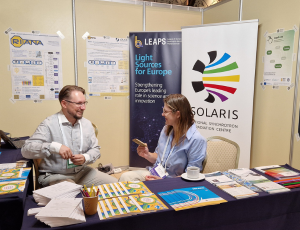 Web Content Display
Web Content Display
SOLARIS centre
 Web Content Display
Web Content Display
A next generation Li-S batteries that are more environmentally friendly
RNDr. Dóra Zalka is a 4th year Ph.D. student in Physics at University Pavol Jozef Šafárik in Košice and at the Institute of Materials Research at Slovak Academy of Sciences. She is originally coming from Hungary, Budapest. She conducts her research at the ASTRA beamline and came to the SOLARIS Centre as part of the Visegrad Grants Programme of the International Visegrad Fund. Dóra’s research focuses on developing a new generation of Li-S batteries made of more environmentally friendly materials. In addition, these batteries will have four- or five-times higher capacity and longer lifespan compared to those currently available on the market.
- Can you explain what your research is about?
My research is focusing on the next generation Li-batteries, made from more eco-friendly materials, with four-five-times higher capacity, and longer lifetime than the currently available batteries on the market.
This is of key importance for the future, as we need more efficient, robust, and inexpensive batteries, both for the growing number of electric vehicles and to support the deployment of renewable energy sources.
These new types of Li-batteries use sulfur in addition to lithium. Sulfur is abundant, eco-friendly, and less expensive than the rare earth metals used now. The idea of the Li-S battery of course is not new. However, achieving a well-working system is still challenging, due to the high-volume expansion of the electrodes during battery operation. Another important problem is that the dissolution of intermediate lithium polysulfide species in the electrolyte leads to irreversible loss of sulfur, resulting in rapid capacity fading. These batteries are still not ready for the industrial level production.
To obtain better performing batteries, I design electrodes with biomass-derived materials, which are extracted from seaweed, algae, plants, or animal proteins. The electrode slurry from which I prepare the electrode is made with these bioderived polysaccharides and water. Currently, on the industrial level the companies are using so-called polyvinylidene fluoride (PVDF) binder material for the electrode slurry, which can be solved only in the very harmful and toxic solvent N-methyl-2-pyrrolidone (NMP). With biomass-derived binders we can eliminate this environmental and health risk from the system. The electrochemical tests that I performed show that a capacity of 1200-1300 mAh/g can be achieved (at a button cell level), and that this capacity remains at more than 80 percent even after 250 charge-discharge cycles.
With the current Li-ion battery-chemistries available on the market, such performance is not available. It is usually an order of magnitude lower, around 140 mAh/g. Additional benefits of these materials are that they can support the electrochemical reaction and trap the harmful side-products through chemical bond formation with the polysulfides.
Of course, this is only one piece of the cake, but it would be a big step forward if such modifications could be implemented in battery production.
- What would you like to achieve with your research?
I hope that my research will contribute to the design of better batteries in the future. Of course, this will also require a better understanding at a physical and chemical level, specifically about how the different components affect battery performance. That's why I investigate the batteries not only from an electrochemical point of view, but also, for example, using X-ray absorption spectroscopy (XAS). Such studies help to understand what materials are formed in the battery during operation, what kind of chemical processes take place, and how the battery components react with each other. The quantitative determination of the amount of polysulfides, sulfur and sulfate components are also important. We can consciously design and select the cathode components based on the electrochemical and XAS results.
- How does ASTRA beamline help your research? Why did you choose this beamline?
In designing my experiments, it was very important to find a beamline where it was possible to perform X-ray absorption measurements at the S K-edge and where we were not afraid to take on some serious challenges, perhaps even being pioneers. ASTRA was especially designed for measurements in the tender X-ray range, i.e., at the K absorption edges of important elements such as P, S, Si, Al and Mg. Thanks to the careful planning and the high quality professional support I obtained during my time at ASTRA beamline, we have been able to make measurements, to the best of our knowledge, for the first in the world. The significance of this is that we managed to measure absorption spectra of the samples not only in fluorescence mode (where we obtain signal from limited thickness of the sample and the signal could be disturbed by self-absorption effect), but also in transmission mode, where the X-rays are passing through the entire volume of working (i.e., during charge and discharge) Li-S batteries and are detected directly, which is very challenging due to low penetration possibilities of tender X-rays . This was possible with the specially designed in-operando cell and cell holders, developed here at SOLARIS in the frame of our common work. By measuring in transmission, we have been able to quantify the components with an accuracy previously unachievable since so far only fluorescence signals could be measured in such systems, which are always have significant self-absorption and are therefore not necessarily suitable for precise quantitative calculations.
Figure 1 Most important limitations of the Li-S battery system
Figure 2 1) In-operando cell designed for transmission measurements, 2) Sample holder designed at the SOLARIS, 3) in-operando cell mounted to the sample holder – the photosensitive paper shows the beam position, 4) calibration samples: sulfur, Li-polysulfides, electrolyte background, 5) comparison of the fluorescence and transmission signal, 6) XANES spectra measured in-operando in transmission, 7) XANES spectra measured in-operando in fluorescence and their 2D representation.
I would like to express my special thanks to Dr. Alexey Maximenko, who supported me with his professional advice during the whole time and to MSc. Eng. Marcin Brzyski who designed the special sample holder for the in-operando cells. I am grateful for Dr. Alen Vizintin (from National Institute of Chemistry, Ljubljana, Slovenia) and for Dr. Pál Jóvári (from Wigner Research Centre for Physics, Research Institute for Solid State Physics and Optics, Budapest, Hungary) for their collaboration, valuable advice and help in the frame of this project.
The further development of ASTRA beamline at NSRC SOLARIS for measuring at low photon energies was supported within the EU Horizon2020 program (952148-Sylinda). The participants acknowledge the CERIC-ERIC Consortium for the access to experimental facilities and financial support, the Slovak Research and Development Agency under the contract No. APVV-20-0138 and the Visegrad Fund under the contract No. 62320092.



